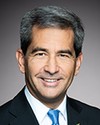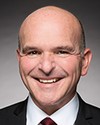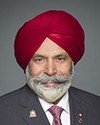Thank you very much, Mr. Chair and committee, for inviting us to join you here today. We sincerely appreciate the invitation and the honour of being able to provide our perspectives to the committee.
My name is Dianne Balon, and I am the vice-president of government at Alberta Blue Cross. Accompanying me today is my colleague Margaret Wurzer. Margaret is a pharmacist by training.
As Alberta Blue Cross is a leading benefits carrier, we provide a full range of supplementary health benefits. Prescription drug coverage is one of the main benefits provided through the plans that we administer. Alberta Blue Cross is a not-for-profit organization, and we have a unique legislative mandate to serve the health and wellness of Albertans.
Our company administers and provides benefits coverage for both the private and the public sectors. Our plans include publicly funded, government-sponsored benefit plans for the Government of Alberta, as well as for the Government of the Northwest Territories; employer-sponsored benefit plans—we currently have over 5,700 employer group plans, some of these from publicly funded organizations and others entirely privately owned—and we also provide health benefits that individuals can purchase, for those who are self-employed or who have retired early.
Collectively, across these plans, Alberta Blue Cross provides prescription drug coverage to more than 1.6 million Albertans.
We are also part of the Canadian Association of Blue Cross Plans, which is collectively the largest not-for-profit benefit carrier in Canada, providing coverage to more than seven million Canadians.
Given the diversity of the customers we serve, along with many of our counterpart Blue Cross plans, we have a unique perspective on the provision of prescription drug benefits that is applicable to the discussion surrounding pharmacare. Our experience with these different plan sponsors highlights their varying objectives and philosophies, which form the basis for their decisions about the prescription drug coverage they offer.
As you know, publicly funded government-sponsored programs provide benefits essential for the societal good, typically with a focus on select populations, such as seniors, the vulnerable in social services programs, or those with specific disease conditions like cancer and organ transplant. Coverage decisions are guided by government policy, and as these programs are funded using taxpayer dollars, there is the ongoing challenge of sustainable funding. We typically see a traditionally smaller basket of drug products within their formularies.
Employers provide group benefits in the interest of keeping employees healthy and productive, and as part of an employee's overall compensation package. An employer's decisions regarding which drug to cover may be defined by union contracts or by the desire to maximize employee productivity—making sure they are at work and productive and not away sick—and to minimize disability claims, while ensuring they are providing a competitive compensation package. As a result, employer plans typically provide quite broad baskets of drugs on their plans. However, as employers are funding this coverage directly, they are well aware of benefit costs and the need to ensure plan sustainability.
Individual health plans—which are a rapidly growing segment of the benefit plan market in Canada, as more and more individuals are self-employed, working on contract or part time, or retirees—are self-funded by the individuals who pay for them. Individuals still want to have good coverage, with a focus on overall cost control, with formularies that are typically more narrowly defined or have more cost control mechanisms than a standard employer-sponsored plan.
All three of these market segments are faced with a common challenge—escalating drug costs and serious concerns about the viability of their drug plans.
We know there are a number of factors contributing to the increased drug benefit costs for plan sponsors. I'm sure you've heard them all. This includes an aging demographic and increasing prevalence of chronic disease, coupled with newer, more expensive therapies for currently treated diseases, as well as new drug therapies for diseases that had no drug treatments in the past.
As you know, more and more of the new drugs coming to the market are specialty drugs and typically cost in excess of $10,000 per patient per year, many treating common chronic medical conditions. Add to this the exorbitant costs of the orphan drugs to treat rare diseases.
While these drug cost pressures create significant challenges for benefit plans, we do recognize that many of these treatments can be life-changing, improving health outcomes and, in many cases, keeping patients out of the primary health care system. The challenge is how to fund these therapies in a sustainable manner on the benefit plan.
As our presentation comes in the context of the committee's already having heard from close to 80 witnesses, we have reviewed all prior presentations and concur with many of the comments that have already been made regarding the need for fundamental reforms.
We believe that, prior to the consideration of the value of a national pharmacare program, the following key policy changes should come first, as they advance the principles of pharmacare by promoting sustainable, more equitable access for Canadians.
First is a substantial decrease in Canadian prescription drug pricing. We believe that immediate action in this area will be foundational to ensuring that we have viable drug coverage in the future. We look forward to the work that the federal Minister of Health is already undertaking as part of her mandate to make sure drugs are affordable, accessible, and appropriately prescribed. The minister has stated that dramatic lowering of drug costs can be achieved with a few regulatory and guidance changes for the PMPRB, and we are fully supportive of her leadership in this regard.
We also see tremendous value in the partnership opportunities of the pan-Canadian pharmaceutical alliance and encourage this organization to work collaboratively to lower all drug prices for all Canadians.
Second is enhancing collaboration between the public and private sectors. With the current environment, we see many silos in public versus private, and we do believe there are many opportunities for streamlining administration and bringing efficiencies to the current processes.
For example, with our collaborative relationship with the Government of Alberta, we have been successful in establishing a process for securing consistent drug pricing across our public and private plans. In the Province of Alberta, we also operate under one pharmacy agreement that we have with the pharmacies, which provides for consistent dispensing fees and additional markups on drug costs for all our plan sponsors, both private and public. Albertans have benefited, as this has helped, to an extent, to control drug costs and increase plan sustainability for both sectors.
Now, moving to access, funding for high-cost orphan drugs is an area that poses substantial challenges to the sustainability of all drug plans, whether public or private. For these drugs, collaboration between public and private payers will be required to establish national coverage policies to ensure that the relatively small number of Canadians who need high-cost orphan drugs will have equitable access.
For other drugs, the topic of what is appropriate access is one that we struggle with, as how one defines medically necessary, appropriate, or equitable access may be determined by the objective for providing coverage. As an example, if your objective for providing benefits is to ensure that your employee is not on disability, you may think that a formulary with a small basket of drugs, one that does not include coverage for medication that will get your employee back to work faster, does not provide an appropriate level of access.
We recognize that the mandate of the committee is to consider national pharmacare, with a focus on drug benefits. However, as a provider of not only drug benefits but other extended health, dental, life, and disability benefits, and with our legislative mandate to serve the health and wellness of Albertans, we are cognizant of the implications of looking at the issue of drug benefits in isolation.
Any changes to the funding model for drug coverage should consider the potential implications it could have to the coverage level for other health benefits. These benefits include things like diabetic supplies, psychology services, physiotherapy benefits, wellness initiatives, and a host of other medical services that address individuals' health needs holistically.
In closing, Alberta Blue Cross congratulates the committee for undertaking a study into the value of national pharmacare. After reading all the information, we appreciate that this is a massive undertaking.
We sincerely thank you for the opportunity to bring forward and share our perspectives today. We welcome the opportunity to answer your questions and to be an integral part of the solution going forward.











